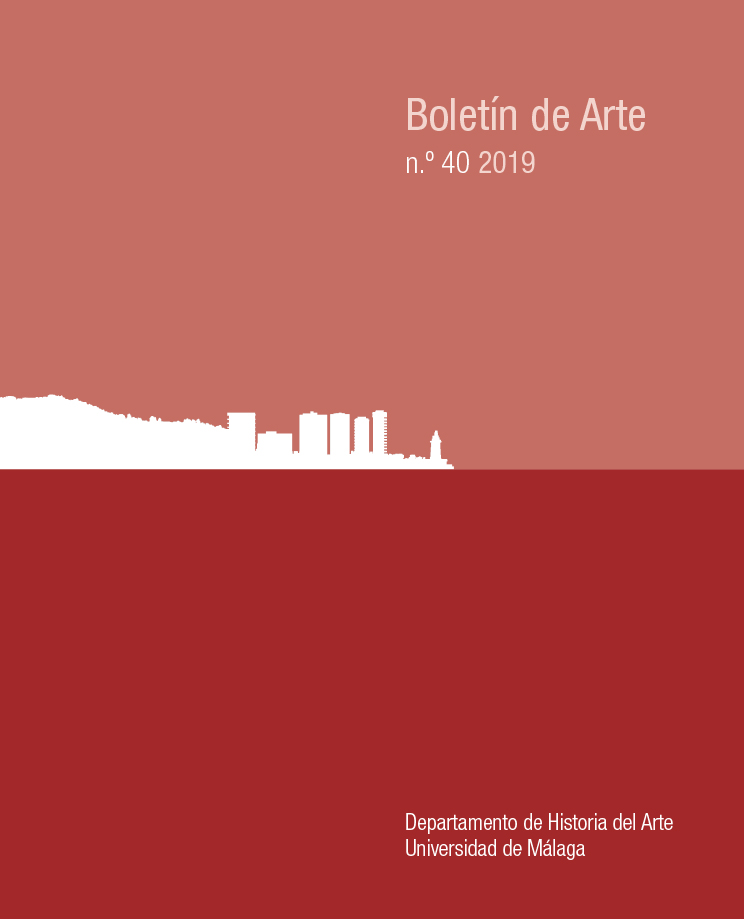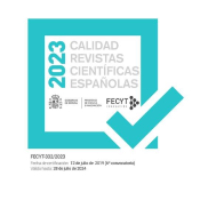Mirar a las aves mirar… y hacer (arte)
DOI:
https://doi.org/10.24310/BoLArte.2019.v0i40.6642Resumen
Mirar a los (demás) animales es una actividad humana muy extendida, sea en un sentido más tangible, o más conceptual, como por ejemplo hace W. J. T. Mitchell en su ensayo “Illusion: Looking at Animals Looking”. Según una de las conclusiones y propuestas de este autor, quizás tendríamos que volver a aprender cómo mirar a los animales. Tal y como llevan décadas haciendo los estudios animales, este artículo se acerca a las perspectivas de éstos, y en concreto, de las aves, para tratar de considerarlos en sus propios términos, más allá de los términos humanos. Para ello, reúne una serie de historias mediante las cuales dialoga con el texto y la estructura planteada por Mitchell no sólo para mirar a las aves mirar, sino también ejercer su agencia, y hacer. Incluso ilusionismo, y arte, desdibujando con ello los límites entre animales humanos y no humanos.
Descargas
Métricas
Citas
ANDERSON, Barton L. (2012), “Bird-brained illusionists”, Science, vol. 335, n.º 6066, pp. 292-293.
AUST, Ulrike y HUBER, Ludwig (2006), “Picture-object recognition in pigeons: Evidence of representational insight in a visual categorization task using a complementary information procedure”, Journal of Experimental Psychology: Animal Behavior Processes, vol. 32, nº. 2, pp. 190-195.
AUST, Ulrike y HUBER, Ludwig (2010), “Representational insight in pigeons: comparing subjects with and without real-life experience”, Animal Cognition, vol. 13, nº. 2, pp. 207-218.
BERGER, John (1991), “Why look at animals?”, About looking. Vintage International, Nueva York, pp. 2-28.
BURKE, Edmund (1757), A Philosophical Inquiry into the Origin of Our Ideas of The Sublime and Beautiful With Several Other Additions, R. and J. Dodsley, Londres.
CHIPP, Herschel B. (1995), Teorías del arte contemporáneo: fuentes artísticas y opiniones críticas, Akal, Madrid.
“Chubu Electric uses artificial nests so crows don’t build their own on power towers” (2017), The Japan Times Online, 22 de mayo. Recuperado de: https://www.japantimes.co.jp/news/2017/05/22/national/chubu-electric-uses-artificial-nests-crows-dont-build-power-towers/
CORNELL LAB OF ORNITHOLOGY (2015), He Delivers Flowers: Vogelkop Bowerbird [en línea]. <https://www.youtube.com/watch?v=_Dq437HuhO0>. [Consulta: 06/07/2019].
CORTÉS ZULUETA, Concepción (2016), Fundamentos biológicos de la creación: Animales en el arte y arte animal, Universidad Autónoma de Madrid.
DAWKINS, Marian Stamp (1993), Through Our Eyes Only? The Search for Animal Consciousness, W. H. Freeman, Spektrum; Oxford , New York.
DE WAAL, Frans de (2007), Primates y filósofos: la evolución de la moral del simio al hombre. Paidós, Barcelona.
DE WAAL, Frans B. M. (2008), “The Thief in the Mirror”, PLoS Biology, vol. 6, nº. 8, p. e201.
DEBITINCO (2007), “Woodpecker?? Attacking the Chimney Flashing”, Houzz, [en línea]. <http://www.houzz.com/discussions/2134041/woodpecker-attacking-the-chimney-flashing>. [Consulta: 22/06/2019].
DELIUS, Juan, EMMERTON, Jacky, HÖRSTER, Wolfgang, JÄGER, Ralph y OSTHEIM, Joachim (2000), “Picture-object recognition in pigeons”, en FAGOT, Joël (ed.), Picture perception in animals, Psychology Press, Hove, pp. 1-35.
DIAMOND, Jared (1986), “Animal art: Variation in bower decorating style among male bowerbirds Amblyornis inornatus”, Proceedings of the National Academy of Sciences, vol. 83. nº. 9, pp. 3042-3046.
ENDLER, John A., ENDLER, Lorna C. y DOERR, Natalie R. (2010),“Great Bowerbirds Create Theaters with Forced Perspective When Seen by Their Audience”, Current Biology, vol. 20, nº. 18, pp. 1679-1684.
FISHER, James y HINDE, Robert A. (1949), “The opening of milk bottles by birds”, British Birds, vol. 42, pp. 347-357.
FRITH, Clifford B. y FRITH, Dawn W. (2008), Bowerbirds: Nature, Art and History, Frith & Frith, Malanda, Queensland.
FRITH, Clifford B., FRITH, Dawn W. y BARNES, Eustace (2004), The bowerbirds: Ptilonorhychidae, Oxford University Press; Oxford , Nueva York.
KALOF, Linda (2007), Looking at animals in human history, Reaktion Books, Londres.
KELLEY, Laura A. y ENDLER, John A. (2017), “How do great bowerbirds construct perspective illusions?”, Royal Society Open Science, vol. 4, nº. 1, p. 160661.
LEFEBVRE, Louis (1995), “The opening of milk bottles by birds: Evidence for accelerating learning rates, but against the wave-of-advance model of cultural transmission”, Behavioural Processes, vol. 34, nº. 1, pp. 43-53.
MARLER, Peter (1996), “Social Cognition: Are Primates Smarter than Birds?” en NOLAN, Val y
KETTERSON, Ellen D. (eds.), Current Ornithology, Springer, Boston, pp. 1-32.
MCHUGH, Susan (2009), “Animal farm’s lessons for literary (and) animal studies”, Humanimalia: A Journal of Human/Animal Interface Studies, vol. 1, nº. 1. Recuperado de: https://www.depauw.edu/humanimalia/issue01/mchugh.html.
MIKKELSON, David (2004), “Change Is in the Air! Do photographs show thieving birds stealing quarters from a car wash?”, Snopes [en línea]. <https://www.snopes.com/fact-check/change-is-in-the-air/>. [Consulta: 24/06/2019].
MITCHELL, W. J. T. (1995), “Illusion: Looking at animals looking”, Picture Theory: Essays on Verbal and Visual Representation, Univ. of Chicago Press, Chicago, pp. 329-344.
MYBACKYARDBIRDING (2016), Northern Flicker Woodpecker Pecking a Metal Chimney Cap [en línea]. <https://www.youtube.com/watch?v=GrEbH3MwHSA>. [Consulta: 22/06/2019].
O’CONNOR, Mike (2004), “Flickers on Chimnies”, The Cape Codder, 2 de abril. Recuperado de: http://www.birdwatchersgeneralstore.com/chimney.htm
PBS (2009), FRONTLINE/World | West Papua: The Clever One | PBS [en línea]. <https://www.youtube.com/watch?v=zuqqGYr2a5Y>. [Consulta: 07/07/2019].
PLINIO, El Viejo (1988), Textos de historia del arte, Visor, Madrid.
SEWALL, Katy (2015), “The girl who gets gifts from birds”, BBC News Magazine, 25 de febrero. Recuperado de: https://www.bbc.com/news/magazine-31604026
SIELMANN, Heinz (1967), “Amblyornis macgregoriae (Ptilonorhynchidae) - Behängen des ‘Maibaumes’ und Balz”, [en línea] <https://av.tib.eu/media/16050>. [Consulta: 02/07/2019].
UEXKÜLL, Jakob von (1922), Ideas para una concepción biológica del mundo, Calpe, Madrid.
VASARI, Giorgio (1912), Lives of the most eminent painters, sculptors & architects, vol. VI, Macmillan and Co. Ld., Philip Lee Warner [for] The Medici Society, Londres.
VON UEXKÜLL, Jakob y KRISZAT, Georg (1957), “A Stroll Through the Worlds of Animals and Men. A Picture Book of Invisible World”, en SCHILLER, Claire H. (ed.), Instinctive Behavior. The Development of a Modern Concept, International University Press, Nueva York, pp. 5-80.
WATANABE, Shigeru (2001), “Van Gogh, Chagall and pigeons: picture discrimination in pigeons and humans”, Animal Cognition, vol. 4, nº. 3, pp. 147-151.
WATANABE, Shigeru, SAKAMOTO, Junko y WAKITA, Masumi (1995), “Pigeons’ discrimination of paintings by Monet and Picasso”, Journal of the Experimental Analysis of Behavior, vol. 63, nº. 2, pp. 165-174.
WEIN, Amelia, GAJDON, Gyula K. y SCHWING, Raoul (2015), “Picture - Object Recognition in Kea ( Nestor notabilis )”, Ethology, vol. 121, nº. 11, pp. 1059-1070.
WEISMAN, Ronald G. y SPETCH, Marcia L. (2010), “Determining When Birds Perceive Correspondence Between Pictures and Objects: A Critique”, Comparative Cognition & Behavior Reviews, vol. 5, pp. 117-131.
Descargas
Publicado
Cómo citar
Número
Sección
Licencia
Todos los contenidos publicados en la revista Boletín de Arte están sujetos a la licencia Creative Commons Reconocimento-NoComercia-Compartirigual 4.0 cuyo texto completo puede consultar en <http://creativecommons.org/licenses/by-nc-sa/4.0>

Los/as autores/as cuyas contribuciones sean aceptadas para su publicación en esta revista conservarán el derecho no exclusivo de utilizar sus contribuciones con fines académicos, de investigación y educativos, incluyendo el auto-archivo o depósito en repositorios de acceso abierto de cualquier tipo.
La edición electrónica de esta revista esta editada por la Editorial de la Universidad de Málaga (UmaEditorial), siendo necesario citar la procedencia en cualquier reproducción parcial o total.











4.png)
